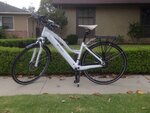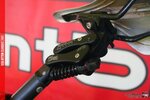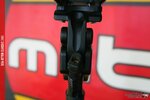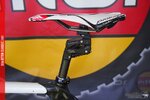You are using an out of date browser. It may not display this or other websites correctly.
You should upgrade or use an alternative browser.
You should upgrade or use an alternative browser.
Body Float Suspension Seat Post Thoughts
- Thread starter James
- Start date
I have a Body Float on my Evo Jet and I love it. The bike is much more comfortable to ride. For whatever reason (I don't understand), the bike also handles better - I take turns with more confidence. I carried the allen wrench with me and made adjustments on the road (when I was stopped) until I got it where I wanted it.
Jonah,
Great to hear. The Easy Motion West Coast Sales Manager has 3 BodyFloats, he travels with it on his demo Evo's as well as his personal road and CX bikes. And good on the Brooks. So why does it make the bike handle better? That's some of the benefits of our unique design features. Now that your motor (you) is staying connected to the bike through turns and terrain, your control, confidence and power will increase. When you control your bike with your torso and hips, it is much more efficient than just moving your weight around and steering. Only use your arms and legs to fine tune...it's synonymous with counter-steering a motorbike. We're working on getting a hand-tune knob to replace the pre-load bolt. It makes a HUGE difference to be able to tune while you ride so you can make minor adjustments on the fly to accommodate terrain and dial in your desired feel. Thanks again...enjoy your many miles ahead.
Thanks Jonah...enjoy your miles. I'll share this shot on our FB page. Cheers.View attachment 2922 Here is a picture of my bike with the Body Float and Cambrium saddle
Ha...no worries. We'll welcome any beauty shots whenever you can get them! Cheers.Sorry the background was not prettier. I stopped in front of some houses I was riding by and snapped the picture.
Mike Smith
Active Member
Well tonight I rode about 20 miles on my new out of the box Brooks B17 S Aged saddle and pretty much dialed in Bodyfloat post and I can finally can say Wow! This saddle is perfect with the BF post even without any pre-treatment. It took a few adjustments to get it to feel right, just slightly leaning forward beyond level, to make it feel perfect, but once dialed into the right position with the right BF setting it was AWESOME. You don't feel the difference right away but after a few miles you realize you haven't been thinking about your butt on the seat. Yes you still need to get off your ass for major bumps like you should, but the overall ride is great! I never thought that fat guy like me could ride a leather Brooks saddle, but the Aged model has just enough give out of the box with no pre-treatment to work incredibly. This combination is incredible, expensive yes, but I think my BF and Brooks B17 S Aged saddle will outlast me. This is such a weird combination of old and new school technology that it actually makes perfect sense. And the look of the old school light brown leather saddle on my ebike is too cool for words. Sorry if I'm dating myself with words like cool, but it is. I just wish it didn't say "Ladies Standard" on the side of the saddle, lol, but that is a completely different thread, lol. The great thing is that the nose is long enough to provide support and stability without being in the way or causing discomfort. Perfect set up and I will ride this combo until they plant me in the ground, lol. I bought enough Proofide and Obenaufs leather oil and heavy duty LA conditioner to treat a ship, and would be I interested in thoughts on conditioning a Brooks saddle...I know it has to be conditioned/ treated, but it feels good already. Lots of different opinions out there on how to treat a Brooks saddle. And I still don't understand why you can't put Proofide or other treatments on the top of the B17 S Aged saddle. Thanks for any responses.
Mike, Towson, MD
Mike, Towson, MD
Last edited:
Well tonight I rode about 20 miles on my new out of the box Brooks B17 S Aged saddle and pretty much dialed in Bodyfloat post and I can finally can say Wow! This saddle is perfect with the BF post even without any pre-treatment. It took a few adjustments to get it to feel right, just slightly leaning forward beyond level, to make it feel perfect, but once dialed into the right position with the right BF setting it was AWESOME. You don't feel the difference right away but after a few miles you realize you haven't been thinking about your butt on the seat. Yes you still need to get off your ass for major bumps like you should, but the overall ride is great! I never thought that fat guy like me could ride a leather Brooks saddle, but the Aged model has just enough give out of the box with no pre-treatment to work incredibly. This combination is incredible, expensive yes, but I think my BF and Brooks B17 S Aged saddle will outlast me. This is such a weird combination of old and new school technology that it actually makes perfect sense. And the look of the old school light brown leather saddle on my ebike is too cool for words. Sorry if I'm dating myself with words like cool, but it is. I just wish it didn't say "Ladies Standard" on the side of the saddle, lol, but that is a completely different thread, lol. The great thing is that the nose is long enough to provide support and stability without being in the way or causing discomfort. Perfect set up and I will ride this combo until they plant me in the ground, lol. I bought enough Proofide and Obenaufs leather oil and heavy duty LA conditioner to treat a ship, and would be I interested in thoughts on conditioning a Brooks saddle...I know it has to be conditioned/ treated, but it feels good already. Lots of different opinions out there on how to treat a Brooks saddle. And I still don't understand why you can't put Proofide or other treatments on the top of the B17 S Aged saddle. Thanks for any responses.
Mike, Towson, MD
Very good to hear Mike. And good to hear the Brooks saddle confirmation as a perfect combo with the BodyFloat. Enjoy your many miles ahead!
Mike Smith
Active Member
Very good to hear Mike. And good to hear the Brooks saddle confirmation as a perfect combo with the BodyFloat. Enjoy your many miles ahead!
Great combo and I'm not getting paid for this. I was blown away by the combo of Brooks saddle ( pre-aged, whatever that means), and BF seat post. Brooks saddle has lots of flex with the open under seat design. Pre-tighten the laces slightly and what a great ride. Can't wait to go for 30 miles or more on my Diamondback Trace.
Mike Smith
Active Member
---
Mike,
What you've described is expected. With no-preload, full movement of your mass will cause the system to bottom out at 260 lbs. Think of it this way, once a mass is in motion, it tends to stay in motion so as you dialed the pre-load down, you got less movement and travel of your mass. So we want to control that movement. with both the BodyFloat AND via your riding style. At 260, you are near the top of our recommended weight scale. The Orange/Orange springs will provide you with an 'A' feel as per our chart. Regarding getting your post set to neutral, compressing a O/O to 4 will provide very little, if no, active range but should stabilize your mass. Backing off those 2 turns into 'Cadillac' mode should give you some reprieve but I think you can get more with some tricks.
It sounds like you're a relatively upright rider and therefor riding with more percentage of mass in the saddle. I'd recommend removing one of the upper elastomers. this will give you a bit more free travel, the trade off is that that bottom out will be more pronounced when you hit bigger features. The goal here is to find the right combo of travel and still support your weight. The bounce you mentioned should be eliminated by removing the elastomers and working on smoothing your pedal stroke. Again, with a higher mass, the system is going to react to your mass more. Couple of comps for you: we have a local boy who's 265 and rides an Orange over Black on a road bike. His stroke is smooth and has plenty of travel for his riding style and desire on his road bike, pre-load is about a 2. An industry Gravel-Grinder reviewer is 240 and rides a Orange over Black and swears by it. I've also put a 350 lb guy on board and he naturally bottomed out the system (Orange/Orange) when just sitting, but as he engaged the pedals he felt the system offering him plenty of support...and suspension. So generally, the lighter the spring rate the better the isolation and control you'll achieve. Be conscience of both your pedal stroke and adjusting slightly as you roll over features that need attention (like speed bumps or holes in the road), but you should be able to maintain your output through a much more broader range of terrain surface features. When climbing you should really be able to take advantage of the system and use your mass to your advantage.
So remove those upper elastomers (with the post on your bike, and saddle on, remove all pre-load, remove both lower side links by taking out the small side bolts and gently prying off the links, the system will cantilever forward and carefully remove the upper spring guide, remove the elastomers and put it all back in place. Those side bolts only get 3nm of torque). When you set your neutral, practice doing this while riding and using the feel rather than just sitting on saddle stationary. Fine tune the pre-load to achieve a firm feel at your regular output and position. Goal here is to build a solid foundation. Then dial in your saddle height. From there back off the pre-load to your desired feel. It's important to build the proper foundation for your mass and riding style, then create the feel you desire.
Regarding your saddle selection, most riders have gravitated towards firmer saddles with better results on the BodyFloat. You shouldn't need a cushy saddle that often makes matters worse by increasing surface tissue contact. Another option that is to use a Brooks or other leather saddle. The flex of the leather provides a nice compliment to the system. Hope this helps...call us directly and I'm happy to assist more.
Like I mentioned in a previous post, I dialed back one more turn on the tension bolt (about 4 to five turns from neutral) to a setting of about 2.5, added a Brooks B17 S Aged saddle right out of the box and the ride is amazing. Not like a wow moment immediately but after a few miles I realized I wasn't feeling or thinking about any butt issues. Love this combination and the look of old school and new technology is very cool. Thanks!
Pastabatman
Member
Hi @Patrick, any updates? When might that become available?We're working on getting a hand-tune knob to replace the pre-load bolt. It makes a HUGE difference to be able to tune while you ride so you can make minor adjustments on the fly to accommodate terrain and dial in your desired feel.
Pastabatman
Member
Last edited by a moderator:
Pastabatman
Member
Last edited by a moderator:
Adrian
Active Member
Strange how the hand tune knob isn't listed on their website .
PowerMe
Well-Known Member
I have the Suntour and it's not bouncy at all. I think it all depends on how you adjust it and preload the tension. I quite like the Suntour. I also have a Thudbuster. Between the 2 of them I think I prefer the Suntour, but it's a very subtle difference and they are pretty comparable.
Adrian
Active Member
I guess this guy needs to work on his then;I have the Suntour and it's not bouncy at all. I think it all depends on how you adjust it and preload the tension. I quite like the Suntour. I also have a Thudbuster. Between the 2 of them I think I prefer the Suntour, but it's a very subtle difference and they are pretty comparable.
Similar threads
- Replies
- 27
- Views
- 12K
- Replies
- 119
- Views
- 35K
- Replies
- 30
- Views
- 17K
- Replies
- 6
- Views
- 8K






